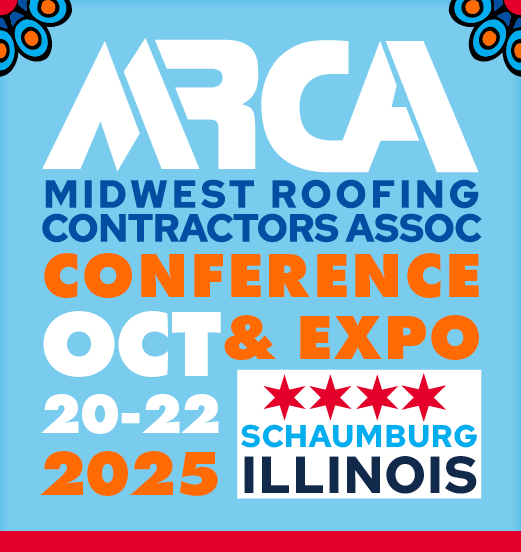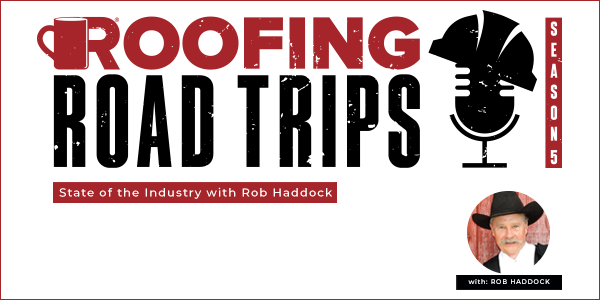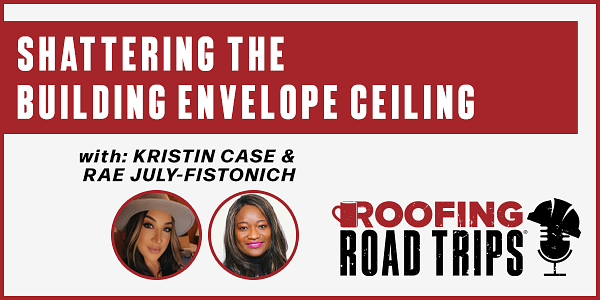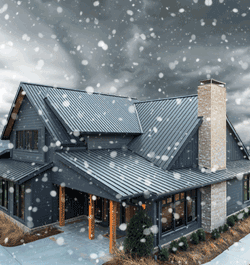Rob Haddock - A State of the Industry - PODCAST TRANSCRIPTION
August 1, 2023 at 3:00 p.m.Editor's note: The following is the transcript of a live interview with Rob Haddock from S-5.You can read the interview below or listen to the podcast.
Intro/Outro: Welcome to Roofing Road Trips with Heidi. Explore the roofing industry through the eyes of a long-term professional within the trade. Listen for insights, interviews and exciting news in the roofing industry today.
Heidi J. Ellsworth: Hello and welcome to another Roofing Road Trips from Roofers Coffee Shop. This is Heidi Ellsworth and I am here today with one of my favorite people in the industry. And I don't say that lightly because seriously it reminds me of growing up, being in the country and working with an amazing craftsman, brilliant engineer, and so I just have to say Rob Haddock, thank you for being on Roofing Road Trips with me again today.
Rob Haddock: I think you tell all the guys that.
Heidi J. Ellsworth: Not all of them, not all of them Rob, I have to tell you.
Rob Haddock: It's always good to share some thoughts with you Heidi, and looking forward to it again today.
Heidi J. Ellsworth: I am too. And what I really like is when we do the state of the industry, where we're just in, and today's last day of second quarter. So it's a great time for you and I to chat about what we're seeing and what I really want to hear what you're seeing. But before we get there, please, for those few people out there who don't know you, could you introduce yourself and tell us a little bit about S-5?
Rob Haddock: Sure. My name is Rob Haddock. I am the founder and CEO of S-5. And I'm also the director of the Metal Roof Advisory Group. Back about 1991-ish I had retired from the construction industry, the metal construction industry, or not the industry, but-
Heidi J. Ellsworth: Yeah, contracting.
Rob Haddock: ... contracting. I was contracting prior to that and I retired from contracting and got into full-time consulting and I did a lot of forensic consulting. And so a combination of those two, living those two lives, I was on metal roofs all the time. Millions and millions of square feet of metal roofs. And particularly in the consulting when I was in the consulting practice, and I still am by the way, the Metal Roof Advisory Group, I see a lot of problems on roofs. I get hired a lot of times when people can't solve problems and they need an expert or when they're duking it out in courtrooms of America over the whodunits and what happened and so on. And most or many, if not most of the problems I saw on metal roofs, both during my contracting career and in my consulting practice are involved people mounting things to metal roofs in all the wrong ways. But the problem was that there wasn't a right way. No one had really come up with a right way. And so the whole metal roofing industry took the stance of don't put anything on our roof-
Heidi J. Ellsworth: Right, right, it might fall on you.
Rob Haddock: ... except solving the problem.
Heidi J. Ellsworth: Yeah.
Rob Haddock: But of course, you know and I know people have to put things on roofs, so whether it's a satellite dish or antenna or some HVAC equipment, certainly-
Heidi J. Ellsworth: Yeah, snow retention.
Rob Haddock: [inaudible 00:03:27] and nowadays of course that's grown into solar, but because I'm sure we're going to talk about that as we go along. But anyway, so I did some head scratching and thought, well, for a standing seam roof, the mistakes that were made were penetrating the roof, punching, jamming screws in the roof to hold something in place and oftentimes fixing the roof to the structure when they did that. So not only do you have a hole, but now you're violating the principles of thermal movement and that doesn't work. That roof cycles thermally and fatigues the area where it's attached and just a lot of bad things happen.
So in 1991 or so, I invented a concept to attach things to standing seam metal roofs without penetration and without violating thermal movement principles of the design of the roof. And that's what evolved into the S-5 product, family of products. And so over the years we've been awarded 112 patents to date and we just keep thinking of better ways, inventing and reinventing, thinking of better ways to attach certain things to roofs. And so we do a lot, we have a line of snow retention systems and we have some proprietary solar attachment systems as well and so on.
Heidi J. Ellsworth: And so important. It's such an integral part of the industry and so important to obviously metal roofing, but to think that there wasn't even a solution before 1991 and now is so ingrained in the industry. I love that.
Rob Haddock: Yeah. Did I ever tell you how long standing seam roofing has been around?
Heidi J. Ellsworth: No. How long?
Rob Haddock: People tend to think it's relatively new. It's been around for about 1200 years.
Heidi J. Ellsworth: Okay, and it took that long to figure out how to safely attach things to it.
Rob Haddock: Yeah. And the technology that I invented was very simple because of my contracting background, easy to install with common tools of trade and relatively inexpensive. In fact, it's actually less expensive than all the wrong ways that people were doing it before. And it's created it's whole category. You're aware, we've been in, we were founded back in 1991, 92, but we're in our 31st year of business and attaching things to metal roofs in prudent ways has become a whole category.
Heidi J. Ellsworth: Yeah. It really has. It just really shows invention, the beauty of invention. And then it just creates a whole... No one would even think about not having this today, whereas, and really for the most part, doing it the right way, not the wrong way.
Rob Haddock: Right. And it's making metal roofing, it makes metal roofing more user-friendly.
Heidi J. Ellsworth: Yes.
Rob Haddock: I think metal roofing is the most user-friendly roof there is. And aside from all its other attributes of durability and life expectancy and all that kind of stuff, it's also the easiest roof that there is to attach things to.
Heidi J. Ellsworth: And it's more, to be able to attach things to the roof is really more important than ever. When you think about all the technology that goes up there, solar, snow retention of course is of the ages. But to me, I just keep thinking that the acres of roofing that we have out there is only going to become more and more important for us to use it for ROI for our buildings. And so you're making that possible.
Rob Haddock: Right. And solar's a big piece of that too.
Heidi J. Ellsworth: Yeah.
Rob Haddock: We're seeing power generation systems mounted on rooftops now.
Heidi J. Ellsworth: Yeah, and it's going to be everywhere. Why not use those acres? Okay, so with that in mind, I do want to, and you get around and I know it, you're everywhere and you're involved in so many different great associations, but what are you seeing in the metal construction industry so far this year, 2023?
Rob Haddock: Well, in general, I see a slowing in the building construction industry in general. However I belong, this company belongs to MBMA, the Metal Building Manufacturers Association, and they publish some statistics from their membership. And I'm not at liberty to share exact statistics from those reports because it's a membership-only thing. But I can tell you that the first two quarters of this year are ahead by at least low double digits of the same two quarters last year.
Heidi J. Ellsworth: That's good news.
Rob Haddock: So, yeah, as a barometer for now, that's one segment of the metal construction industry, but it's a large one and that is up from the same two quarters last year. Having said that, it's only up small single digits from the last quarter of 2024.
Heidi J. Ellsworth: Okay.
Rob Haddock: Sorry, 2022.
Heidi J. Ellsworth: 2022. Right, yeah. I don't know Rob, how you're seeing this, but it seems to me like it's okay to have a little bit slower growth. It's this as long as we're growing or taken care of. To me it's like after the last three or four years, I don't mind a little bit, not a lot, but a little bit slower growth.
Rob Haddock: I'm with you Heidi, and I think most people are as well. We've really seen some crazy times. We want to talk about the state and the future of the industry and my head goes everywhere because there has been no such thing as normal for a number of years now. But why did I say all that?
Heidi J. Ellsworth: Because of that growth. We do need it to be a little realistic.
Rob Haddock: Oh, we do need it to. Everybody is crying for help. Contractors in almost every trade have been so backlogged they can't take on new work. That has to slow down. And so from that perspective, a bit of a slowdown is not a bad thing.
Heidi J. Ellsworth: A little bit. Just a little bit.
Rob Haddock: Yeah. And we can't see boom times forever. You know that. What goes up, must come down or at least level off. And I think that's what we're going to see over the next remainder of this year and into next year is some leveling. But there are exceptions to that. There are geographic exceptions that are still booming. Here where I am outside Colorado Springs, every trade is still busy and backlogged and like a 30 to 60 to even 90 day wait time to get on the list. And that's not healthy for any industry.
Heidi J. Ellsworth: No. And we're seeing that up and down the West Coast too. A lot of it had to do with the huge amount of snow that we had this winter, but there's just a lot of building, there's still a lot of growth. So it's interesting. And now with all the hailstorms that just hit throughout Colorado and Texas, I was just hearing again, it's roofing is as we have these disasters, which is so sad for the people, but it does ramp up the roofing industry that's for sure.
Rob Haddock: It does. I don't think I have talked to a roofing contractor in years, including recent weeks that wasn't just booked out the wazoo. So the roofing trade is certainly one of those that, the electrical trade is another one, but it's just get on the wait list kind of thing. So most of the roofers, in fact all of them that I talked to are still really pretty busy.
Heidi J. Ellsworth: Yeah, I've been hearing the same thing. So I'm really interested to also, speaking of contractors overall, both for roofing and for metal, metal buildings, metal siding, but contractors who are doing, working on buildings and exteriors, what are some of the important trends that you think they should be aware of and incorporating into their business?
Rob Haddock: I think I see a greater number of roofing contractors really looking into offering solar. And it makes sense, but it's a difficult transition because in the solar industry it's a whole different language. It's watts, kilowatts, megawatts.
Heidi J. Ellsworth: Gigawatts.
Rob Haddock: Gigawatts. Inverters and module level power electronics and so it's really a different language. But with the passage of the IRA, that was a big shot in the arm for the roof mounted solar for solar in its entirety and other green energies, but in particular for solar on rooftops. And I think I see a bit, it's slow to make that leap to get into the roofing and roof-mounted solar business, but I think it's something that roofing contractors should really look at and should really consider.
Heidi J. Ellsworth: Yeah, I do too. And that's been going on for years. When we talk about, I started in the roofing industry in '93, you started your business, you'd been in building and construction much before starting your business in '91. During that, the 90s and early 2000s, there was just so much talk about solar, but it never really took off. And so contractors I think thought, it's not that important. It's really not going to take off, but it is now. And the ones who did do it, the ones who were in the front are really reaping the benefits right now. So I think contractors need to look at getting that into their business and also looking at metal because metal really is such a great combination with solar.
Rob Haddock: Well, I'm an evangelist on that topic. And the whole thing of it is that as concerns metal and solar is that metal is the only roof type, as I'm sure you're aware.
Heidi J. Ellsworth: Yes.
Rob Haddock: There have been field studies done and all that kind of stuff that prove that galvalume coated steel standing seam roofing is a 60 plus for roof. Solar, is solar generally lasts in the range of 35 years or so, and so on almost all other roof types a building owner's going to be facing roof replacement before the life of his solar has expired. And that really destroys the financial proforma of that solar system because you got to take it off now. Re-roof, put it back and that involves all kinds of disassembly and reassembly and damage components and so on.
And when you look at that from a cost basis, it's just kind of crazy. It's a little like putting solar, in my opinion... I don't want to offend any of your membrane roof guys, but putting solar on a membrane roof is a little like putting a Ferrari engine on a Punto chassis. Who would do that? And if your roof, and if a building owner has a roof that's already aged 10 years or so-
Heidi J. Ellsworth: It's even worse.
Rob Haddock: ... it's even more devastating than financial proforma. But in talking about the financial proforma, I think that there was a mindset out in at least the commercial and industrial building space that people thought, well yeah, that solar, that's saved the planet, hippies and tree huggers and it doesn't pay for itself for 20 years and so on. Well that was true 15 years ago maybe.
Heidi J. Ellsworth: Right. Maybe. Yeah.
Rob Haddock: But today it makes financial sense. I call myself an environmental capitalist. I'm all about green, especially the kind you fold and put in-
Heidi J. Ellsworth: Yeah. Yes.
Rob Haddock: And we're solarizing three of our S-5 facilities, one of them is complete, the other two are just getting started. But we're solarizing every one of them and the payback on two, on our plant, our warehouse down in Texas, payback was the day it was finished-
Heidi J. Ellsworth: Man. Yeah, wow.
Rob Haddock: I'm not kidding. The day it was finished-
Heidi J. Ellsworth: Paid for.
Rob Haddock: ... it was paid for hundred percent with the incentives and the tax credits and the incentives that were involved. And of course those incentives vary from place to place. The one here at the office where I'm sitting today, this one didn't have one of those incentives that the other two did. But this one pays for itself in, I think 30 months is the payback. And you've got a power plant that is paying your light for the next 30 years.
Heidi J. Ellsworth: That's the thing is that, and of course we want to do all the right things for the planet, for the environment, we want to do all that. And then we've been talking about it for 30 years, but we needed to have all the right pieces of business and green and sustainability and all come together. And it is right now. And I'm really glad you mentioned the fact that you are putting solar on your plants and buildings office because that just right there tells a story.
Rob Haddock: Yeah, well, I think so. I think the story in many cases is too good to believe.
Heidi J. Ellsworth: Yeah, and they're like...
Rob Haddock: And so people just don't believe it because like me, even if there are not incentives beyond the investment tax credit of 30%, even under those conditions, most systems will pay for themselves within six years.
Heidi J. Ellsworth: Yeah. It just makes, to me, it makes so much sense. It's the future. It's where we're going. We're self-sustaining. It makes so much so different. So we're seeing this in the US. I know we're a little bit behind the times when you go internationally, and I know you've been traveling internationally a lot. So I would love, what do you see with the rest of the world when it comes to solar and also any new trends that you're seeing? Because sometimes we're ahead of the curve and sometimes we're not.
Rob Haddock: Well, what I see in the rest of the world, first of all the... First of all, what I see is solar, solar and more solar. The entire world it seems is really, really into this and going solar. The drivers are variable in different places. Obviously one of the big drivers of solar is a trade. You're generating electricity. So you've got to know, in order to do a financial proforma, you've got to know, well, what am I paying for electricity? And so nationally here in the US these numbers can be up and down. But nationally the average is about 12 cents a kilowatt-hour. Okay, so to bring that into focus, we use that to determine a financial performer. We're going to produce so much electricity, it's going to offset at the rate of 12 cents a kilowatt-hour, whatever your specific rate is.
In other parts of the world, in Germany, the cost of electricity is more like 45 cents a kilowatt-hour. In Australia, it's one of the highest rates in the world. It's up closer to 50 cents a kilowatt-hour. In many other areas of Europe and central and South America, the rates, the US enjoys one of the lowest rates in the world of electricity. There are a couple of countries, China and I think it's Russia, have even lower rates than we do here. But almost all the civilized world, the western world, certainly electric rates are two and even three times as high as ours so that's an enormous driver for installing solar in those places.
Heidi J. Ellsworth: And it makes sense. They just don't have the natural resources. I live here in, as you well know, in the Pacific Northwest, we have all this hydroelectricity so it's a different calculation for us. But when you're in Australia and there is no, there's nothing generating that solar is... I always go back, it's self-sustaining.
Rob Haddock: Yep.
Heidi J. Ellsworth: Yeah.
Rob Haddock: Well it is. It is. And solar degrades over time. So those modules don't produce as much electricity in year 10 as they produced in year one. But the rate of degradation is very gradual. And we're talking about maybe a half a percent per year or something like that. And when you look at the inflation rate, you're not losing anything. As long as inflation is over a half a percent per year or whatever that number is, you're still ahead of the game.
Heidi J. Ellsworth: Wow.
Rob Haddock: And it's not like it burns out after a certain amount of time. Just the production gradually gets a little, a little less, a little less.
Heidi J. Ellsworth: That is... Wow, so solar, solar, solar. Any other? Yeah, and I'm interested too in, there's just seems to be so much technology going on around installation of metal roofs, the roll formers, all of those, the machinery that's coming out. What are some of the things you're seeing that way?
Rob Haddock: I don't know that I've seen any real new revolutionary kinds of innovations. Of course, constantly machine producers and equipment producers are better with things, and that's true in our space as well. So making what you have better is something that any forward thinking company does. But I haven't seen anything that just says, wow, this is a game changer. It's just more the same and better and improvements that-
Heidi J. Ellsworth: And it's almost like the robotics are still out there figuring out how this is all going to work. But I do start, I'm seeing a lot more robotics in manufacturing and some trying to get up on the roof. We'll see how that goes.
Rob Haddock: Yeah, that's a good point, Heidi, that robotics and electronics are making huge advances year over year. And we have any number of CNC machines and robotic equipment in our plant down in Texas. And it's, we run that stuff 24/7 as a rule. And it wears out in three years or so. It just starts getting more expensive to maintain and all. So we have to replace that equipment about every three or four years. And it's kind of a good thing we do because within that, it's almost like your computer or your iPhone, that within three or four years it's obsolete and there's a newer, bigger, better whiz banger thing out there on the market. And the same thing in electronics and in machinery and equipment and robotics is, as you say.
Heidi J. Ellsworth: It's moving so fast. It is moving so fast. But I would before we finalize here, I would really love, what is some of your advice to contractors looking into Q3, Q4 and even into 2024 next year? What are some of the things, I know you're going to say solar and so it's that, and then what else? What are some other things that contractors should be thinking about?
Rob Haddock: Well, I think it's easy when you have been so busy that you're turning away work for the last three or four or longer number of years. I think it's easy to develop a sense of complacency. It's always going to be this good and it's not. I've seen cycles in construction economy for almost 60 years now. And it's what goes up will come down, it'll level off. We've seen some crazy bubbles and some crazy things happen with COVID delays and all that kind of stuff. And I think building construction is going to begin to get caught up with the demand. People who wanted to build buildings during COVID, now they're getting them built and it is going to slow down eventually. And so the best advice I think I could give to contractors is the good times are rolling. They have been rolling, but the good times won't roll forever. So stay aggressive, keep your edge, keep looking for new things that you can do or doing business in other ways. One of my favorite sayings is always have a plan B.
Heidi J. Ellsworth: Yeah, always.
Rob Haddock: When the unexpected happens, you always want to have a plan B. What is it?
Heidi J. Ellsworth: Oh, sometimes I go C, D, and E too. Just because you never know how sideways things might go.
Rob Haddock: You're absolutely right because as soon as you exercise plan B if something happens to mess that plan up you need to have a plan C. And it's really, it's the ability to shift that way and not lose momentum, that I think really makes for the longevity of any business.
Heidi J. Ellsworth: I do too. I agree. And I know, and I just want to reemphasize and what we've been talking about here too, the contractors, solar's not going away, and there's huge demand out there for it. Metal roofs are the perfect solution for solar. So as companies are looking at diversifying, growing their business, these are two things that they really need to be taking the opportunity now to get the education and to make the relationships with a company like S-5 to start bringing that into their business if they don't already have it.
Rob Haddock: Amen sister Heidi.
Heidi J. Ellsworth: Amen. Amen. I love it. Speak the word. Here we go. Well, Rob, as always, thank you so much. You just make my day and I love it. Thank you for coming on to Roofing Road Trips.
Rob Haddock: Always a pleasure, Heidi. God bless you.
Heidi J. Ellsworth: Thank you. Such a pleasure. And thank you all for listening. I hope you enjoyed this as much as I did because this is the information and the wisdom that can really help change your business. You can find all kinds of information about S-5 on Roofers Coffee Shop and Metal Coffee Shop in their directory, along with some amazing articles. They have some great webinars that they're doing and their most recent S-5 University. So check it all out. And be sure to catch all of our podcasts under the read listen and watch navigation under podcast and Roofing Road Trips or on your favorite podcast channel. Be sure to subscribe and set your notifications so you don't miss a single episode. And we'll be seeing you next time on Roofing Road Trips.
Intro/Outro: Make sure to subscribe to our channel and leave a review. Thanks for listening. This has been Roofing Road Trips with Heidi from the Roofers Coffee Shop.com.























Comments
Leave a Reply
Have an account? Login to leave a comment!
Sign In